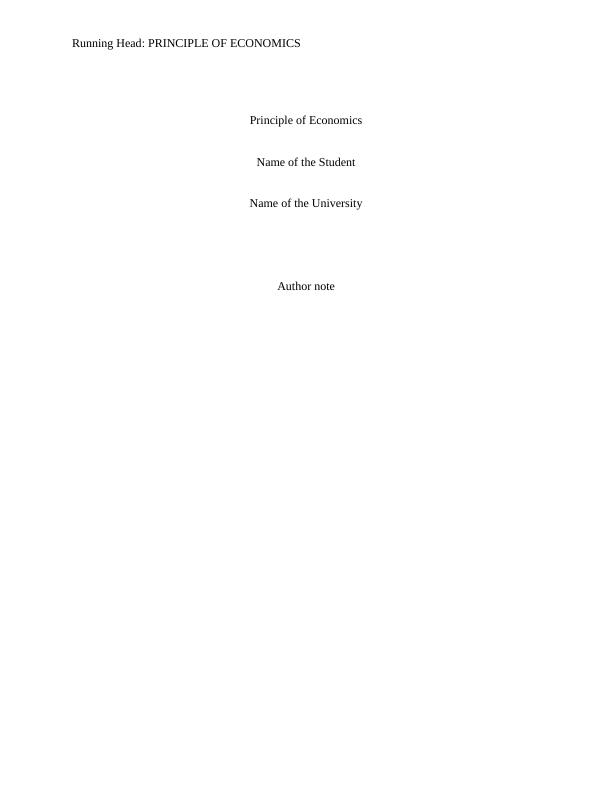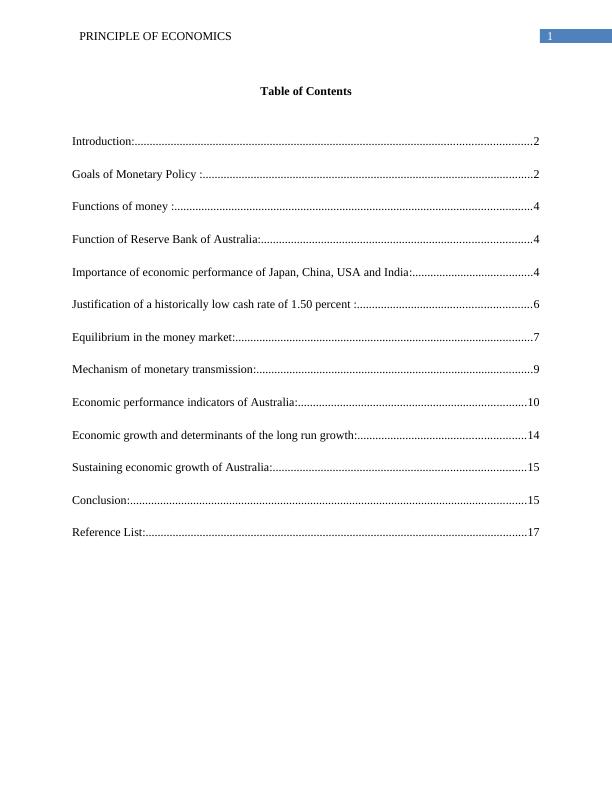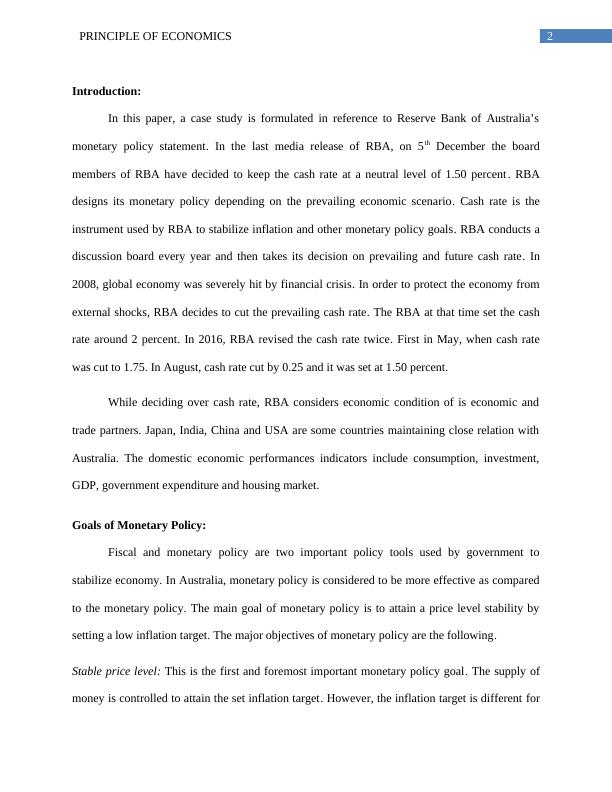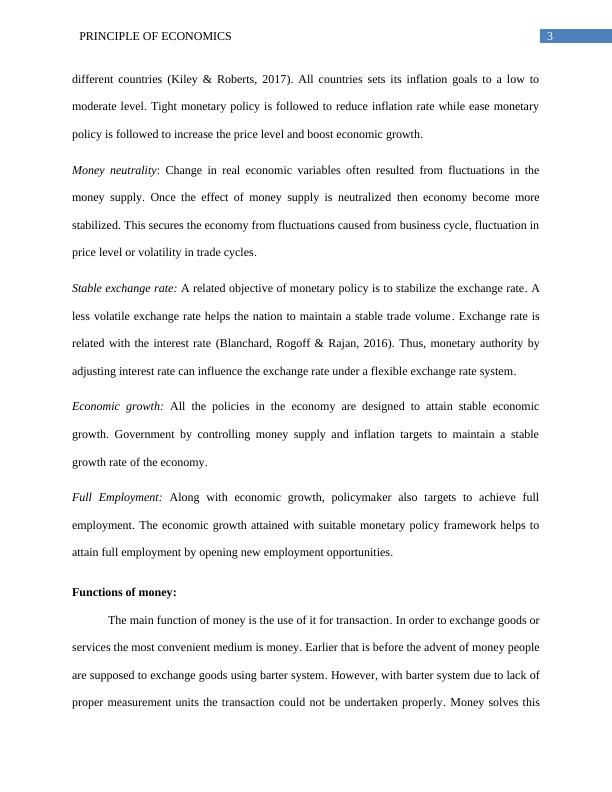Principle of Economics: Monetary Policy, Money Market Equilibrium, and Economic Performance of Australia
Added on 2023-06-15
20 Pages4112 Words59 Views
Running Head: PRINCIPLE OF ECONOMICS
Principle of Economics
Name of the Student
Name of the University
Author note
Principle of Economics
Name of the Student
Name of the University
Author note

1PRINCIPLE OF ECONOMICS
Table of Contents
Introduction:....................................................................................................................................2
Goals of Monetary Policy :..............................................................................................................2
Functions of money :.......................................................................................................................4
Function of Reserve Bank of Australia:..........................................................................................4
Importance of economic performance of Japan, China, USA and India:........................................4
Justification of a historically low cash rate of 1.50 percent :..........................................................6
Equilibrium in the money market:...................................................................................................7
Mechanism of monetary transmission:............................................................................................9
Economic performance indicators of Australia:............................................................................10
Economic growth and determinants of the long run growth:........................................................14
Sustaining economic growth of Australia:....................................................................................15
Conclusion:....................................................................................................................................15
Reference List:...............................................................................................................................17
Table of Contents
Introduction:....................................................................................................................................2
Goals of Monetary Policy :..............................................................................................................2
Functions of money :.......................................................................................................................4
Function of Reserve Bank of Australia:..........................................................................................4
Importance of economic performance of Japan, China, USA and India:........................................4
Justification of a historically low cash rate of 1.50 percent :..........................................................6
Equilibrium in the money market:...................................................................................................7
Mechanism of monetary transmission:............................................................................................9
Economic performance indicators of Australia:............................................................................10
Economic growth and determinants of the long run growth:........................................................14
Sustaining economic growth of Australia:....................................................................................15
Conclusion:....................................................................................................................................15
Reference List:...............................................................................................................................17

2PRINCIPLE OF ECONOMICS
Introduction:
In this paper, a case study is formulated in reference to Reserve Bank of Australia’s
monetary policy statement. In the last media release of RBA, on 5th December the board
members of RBA have decided to keep the cash rate at a neutral level of 1.50 percent . RBA
designs its monetary policy depending on the prevailing economic scenario. Cash rate is the
instrument used by RBA to stabilize inflation and other monetary policy goals. RBA conducts a
discussion board every year and then takes its decision on prevailing and future cash rate. In
2008, global economy was severely hit by financial crisis. In order to protect the economy from
external shocks, RBA decides to cut the prevailing cash rate. The RBA at that time set the cash
rate around 2 percent. In 2016, RBA revised the cash rate twice. First in May, when cash rate
was cut to 1.75. In August, cash rate cut by 0.25 and it was set at 1.50 percent.
While deciding over cash rate, RBA considers economic condition of is economic and
trade partners. Japan, India, China and USA are some countries maintaining close relation with
Australia. The domestic economic performances indicators include consumption, investment,
GDP, government expenditure and housing market.
Goals of Monetary Policy:
Fiscal and monetary policy are two important policy tools used by government to
stabilize economy. In Australia, monetary policy is considered to be more effective as compared
to the monetary policy. The main goal of monetary policy is to attain a price level stability by
setting a low inflation target. The major objectives of monetary policy are the following.
Stable price level: This is the first and foremost important monetary policy goal. The supply of
money is controlled to attain the set inflation target. However, the inflation target is different for
Introduction:
In this paper, a case study is formulated in reference to Reserve Bank of Australia’s
monetary policy statement. In the last media release of RBA, on 5th December the board
members of RBA have decided to keep the cash rate at a neutral level of 1.50 percent . RBA
designs its monetary policy depending on the prevailing economic scenario. Cash rate is the
instrument used by RBA to stabilize inflation and other monetary policy goals. RBA conducts a
discussion board every year and then takes its decision on prevailing and future cash rate. In
2008, global economy was severely hit by financial crisis. In order to protect the economy from
external shocks, RBA decides to cut the prevailing cash rate. The RBA at that time set the cash
rate around 2 percent. In 2016, RBA revised the cash rate twice. First in May, when cash rate
was cut to 1.75. In August, cash rate cut by 0.25 and it was set at 1.50 percent.
While deciding over cash rate, RBA considers economic condition of is economic and
trade partners. Japan, India, China and USA are some countries maintaining close relation with
Australia. The domestic economic performances indicators include consumption, investment,
GDP, government expenditure and housing market.
Goals of Monetary Policy:
Fiscal and monetary policy are two important policy tools used by government to
stabilize economy. In Australia, monetary policy is considered to be more effective as compared
to the monetary policy. The main goal of monetary policy is to attain a price level stability by
setting a low inflation target. The major objectives of monetary policy are the following.
Stable price level: This is the first and foremost important monetary policy goal. The supply of
money is controlled to attain the set inflation target. However, the inflation target is different for

3PRINCIPLE OF ECONOMICS
different countries (Kiley & Roberts, 2017). All countries sets its inflation goals to a low to
moderate level. Tight monetary policy is followed to reduce inflation rate while ease monetary
policy is followed to increase the price level and boost economic growth.
Money neutrality: Change in real economic variables often resulted from fluctuations in the
money supply. Once the effect of money supply is neutralized then economy become more
stabilized. This secures the economy from fluctuations caused from business cycle, fluctuation in
price level or volatility in trade cycles.
Stable exchange rate: A related objective of monetary policy is to stabilize the exchange rate. A
less volatile exchange rate helps the nation to maintain a stable trade volume. Exchange rate is
related with the interest rate (Blanchard, Rogoff & Rajan, 2016). Thus, monetary authority by
adjusting interest rate can influence the exchange rate under a flexible exchange rate system.
Economic growth: All the policies in the economy are designed to attain stable economic
growth. Government by controlling money supply and inflation targets to maintain a stable
growth rate of the economy.
Full Employment: Along with economic growth, policymaker also targets to achieve full
employment. The economic growth attained with suitable monetary policy framework helps to
attain full employment by opening new employment opportunities.
Functions of money:
The main function of money is the use of it for transaction. In order to exchange goods or
services the most convenient medium is money. Earlier that is before the advent of money people
are supposed to exchange goods using barter system. However, with barter system due to lack of
proper measurement units the transaction could not be undertaken properly. Money solves this
different countries (Kiley & Roberts, 2017). All countries sets its inflation goals to a low to
moderate level. Tight monetary policy is followed to reduce inflation rate while ease monetary
policy is followed to increase the price level and boost economic growth.
Money neutrality: Change in real economic variables often resulted from fluctuations in the
money supply. Once the effect of money supply is neutralized then economy become more
stabilized. This secures the economy from fluctuations caused from business cycle, fluctuation in
price level or volatility in trade cycles.
Stable exchange rate: A related objective of monetary policy is to stabilize the exchange rate. A
less volatile exchange rate helps the nation to maintain a stable trade volume. Exchange rate is
related with the interest rate (Blanchard, Rogoff & Rajan, 2016). Thus, monetary authority by
adjusting interest rate can influence the exchange rate under a flexible exchange rate system.
Economic growth: All the policies in the economy are designed to attain stable economic
growth. Government by controlling money supply and inflation targets to maintain a stable
growth rate of the economy.
Full Employment: Along with economic growth, policymaker also targets to achieve full
employment. The economic growth attained with suitable monetary policy framework helps to
attain full employment by opening new employment opportunities.
Functions of money:
The main function of money is the use of it for transaction. In order to exchange goods or
services the most convenient medium is money. Earlier that is before the advent of money people
are supposed to exchange goods using barter system. However, with barter system due to lack of
proper measurement units the transaction could not be undertaken properly. Money solves this

End of preview
Want to access all the pages? Upload your documents or become a member.
Related Documents
Principles of Economics: Monetary Policy, Money Market, and Economic Relations of Australialg...
|22
|4249
|251
Economic Assignment Solution (Doc)lg...
|22
|3517
|52
PRINCIPLES OF ECONOMICS 10 PRINCIPLES OF ECONOMICS Name of the Student Namelg...
|14
|3449
|362
Monetary Policy and the Australian Economy: An Analysis of the Reserve Bank's Decisionlg...
|18
|3642
|349
Principles of Economics | Reportlg...
|18
|4516
|33
Principles of Economicslg...
|19
|3991
|385
